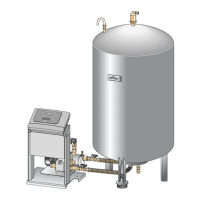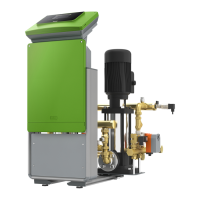Variomat Basic — 22.07.2020 - Rev.A
Note!
If automatic make-up is not connected, you must manually fill
the tanks with water to the recorded filling level.
Note!
The setting values for pressure maintenance, filling levels and
make-up are provided in the chapter Standard settings, see
chapter 8.2 "Variomat switching points" on page 17 .
11.3 Inspection
11.3.1 Pressure-bearing components
Comply with all applicable national regulations for the operation of
pressure equipment. De-pressurise all pressurised components prior to
inspection (see disassembly information).
11.3.2 Inspection prior to commissioning
In Germany, follow the Industrial Safety Regulation
[Betriebssicherheitsverordnung] Section 15 and Section 15 (3) in
particular.
11.3.3 Inspection intervals
Recommended maximum inspection intervals for operation in Germany
pursuant to Section 16 of the Industrial Safety Regulation
[Betriebssicherheitsverordnung] and the vessel classification of the
device in diagram 2 of the Directive 2014/68/EC, applicable in strict
compliance with the Reflex Installation, Operation and Maintenance
Manual.
External inspection:
No requirement according to Annex 2, Section 4, 5.8.
Internal inspection:
Maximum interval according to Annex 2, Section 4, 5 and 6; if
necessary, suitable replacement actions are to be taken (such as wall
thickness measurement and comparison with the design specification
which may be requested from the manufacturer).
Strength test:
Maximum interval according to Annex 2, Section 4, 5 and 6.
Furthermore, compliance with Section 16 of the Industrial Safety
Regulation and Section 16 (1) in particular, in conjunction with Annex 2,
Section 4, 6.6 and Annex 2, Section 4, 5.8, must be ensured.
The actual intervals must be specified by the operating company based
on a safety evaluation taking into consideration the actual operating
conditions, experience with the mode of operation and charging
material and the applicable national regulations for the operation of
pressure equipment.
12 Disassembly
Risk of serious injury or death due to electric shock.
If live parts are touched, there is risk of life-threatening injuries.
• Ensure that the system is voltage-free before installing the
device.
• Ensure that the system is secured and cannot be reactivated by
other persons.
• Ensure that installation work for the electric connection of the
device is carried out by an electrician, and in compliance with
electrical engineering regulations.
Risk of burns
Escaping hot medium can cause burns.
• Maintain a sufficient distance from the escaping medium.
• Wear suitable personal protective equipment (safety gloves
and goggles).
Risk of burns on hot surfaces
Hot surfaces in heating systems can cause burns to the skin.
• Wait until hot surfaces have cooled down or wear protective
safety gloves.
• The operating authority is required to place appropriate
warning signs in the vicinity of the device.
Risk of injury due to pressurised liquid
If installation or maintenance work is not carried out correctly, there
is a risk of burns and other injuries at the connection points, if
pressurised hot water or steam suddenly escapes.
• Ensure proper disassembly.
• Ensure that the system is de-pressurised before performing the
disassembly.
• Prior to dismantling, block off all "water"-side connections to the
device.
• Vent the device to de-pressurise it.
1. Disconnect the system from the power supply and secure it against
unintended reactivation.
2. Disconnect the power cable of the device from the power supply.
3. Disconnect all cables from the terminals of the device control unit
and remove them.
DANGER – Risk of serious injury or death due to electric
shock. Some parts of the device's circuit board may still carry 230 V
voltage even with the device physically isolated from the power
supply. Before you remove the covers, completely isolate the
device controller from the power supply. Verify that the main
circuit board is voltage-free.
4. Disconnect the secondary tank (if provided) on the water side from
the system and the primary tank.
5. Open the "FD" feed and drain cocks at the tanks until they are
completely empty and de-pressurised.
6. Undo all hose and pipe connections to the tanks and the control
unit of the device to the system and remove them completely.
7. If necessary, remove the tanks and the control unit from the
system area.

